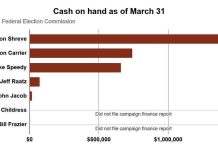INDIANAPOLIS — Lawmakers quietly included $1 million each year to address veteran suicide prevention efforts in the new state budget — a tiny portion of state spending that could provide much-needed help as thousands of veterans die across the country each year at higher rates than their civilian peers.
Even as deaths remain stubbornly high after decades of effort, discussions about suicide and mental health overall still have a stigma in the military, said Matt Hall, the program lead for veteran resources group Indy Warrior Partnership.
“I’ve served almost 30 years in the Army and even I find it difficult to adhere to my own guidance and talk about it,” Hall said. “We get put in certain situations that are difficult and complaining or looking for help… only heaps it onto somebody else and makes their burden twice as much.”
Hall said military resilience classes now encourage creating a small network of friends to call in times of crisis, and is “lightyears” ahead from when he started. But some training still emphasizes the importance of carrying your own load and continuing without complaint.
“That’s great when you’re carrying a rucksack over 25 miles. However, when you’re having suicidal ideations, it’s not a great idea,” Hall said.
While the state’s mental health crisis received a lot of attention in the 2023 legislative session, veterans were the only group singled out by lawmakers for funding. Indiana’s veteran suicide rates are higher than the national average, particularly for the state’s youngest veterans.
Director Dennis Wimer, whose Department of Veterans Affairs would oversee the monies, said the funding would go a long way toward expanding ongoing efforts with hiring and outreach.
“You can’t hire somebody when you don’t have money. And you really can’t do something unless somebody is dedicated and active,” Wimer, an Air Force veteran, said. “That money will come July 1 and we’re in the process of putting out all of the job descriptions and getting those all ready internally so we can get some postings out… to have an employee start as quickly as possible.”
Funding will also go to local organizations – like Hall’s Indy Warrior Partnership – through another $1 million line item for veterans services. Previously, suicide prevention wasn’t among the services covered by the grant, something the General Assembly amended in House Bill 1056.
These organizations are already working to decrease Indiana veteran suicide rates while compiling data. Currently, the state agency relies on two-year old data, undermining its effort to meet the nation-wide “Governor’s Challenge.”
The Governor’s Challenge – shorthand for the Governor’s and Mayor’s Challenges to Prevent Suicide Among Service Members, Veterans, and their Families – embodies a partnership between the U.S. Department of Veterans Affairs (VA) and the Substance Abuse and Mental Health Services Administration (SAMHSA).
Holcomb, a Navy veteran, signed on in September 2020, kickstarting a planning process that now moves into the second, implementation phase, as outlined by SAMHSA. Accomplishments for the challenge include: reducing suicide among service members, veterans and their families; increasing access to services and support; expanding state capacity; identifying critical data; and more.
The VA’s National Veteran Suicide Prevention Annual Report runs two years behind, meaning the 2022 edition details what veteran suicide looked like when Holcomb signed his proclamation in 2020.
Between 2001 and 2020, the rates for veteran deaths by suicide outpaced civilian deaths every year, becoming the 13th leading cause of death among veterans overall in 2020 but the second leading cause in veterans under 45. In 2020, 6,146 veterans died by suicide, a rate of 31.7 deaths per 100,000 veterans.
In Indiana, 150 veterans died that year by suicide, for a rate of 36.5 deaths per 100,000 veterans – higher than the national rate.
But the state’s youngest veterans, those between 18 and 34, had a suicide rate significantly higher than the national average for the same age range in 2020 – 73 Hoosier deaths per 100,000 veterans vs 46.1 national deaths per 100,000 veterans.
“As we work with the Governor’s Challenge, one of the key parts is going to be identifying the metrics that we want to impact,” Wimer said. “It’s hard to wait for two years to get a number that you’re going up or down and then be reactive to that.”
If you or a loved one are experiencing suicidal ideations, call 988 and then press 1 for veteran-specific support. The Veterans Crisis Line also offers the option to text at 838255 or chat online.
Hall noted that the VA released stats show that just over 60% of veterans who died by suicide had no recent engagements with VA health services, meaning they weren’t connected to specialized resources. Outreach, and identifying veterans in local communities, is a vital part of reducing veteran suicide rates.
“We don’t want veterans to be in a struggle or in a situation where they don’t feel that they have a support network,” Hall said.
This lack of connection is the foundation for Priority Area 1 of the Governor’s Challenge – identifying and screening service members – and Priority Area 2 – promoting connectedness and improving care transitions.
But the challenge includes a third priority – increasing lethal means safety and safety planning – that Hall said is sometimes misunderstood, even though it impacts the vast majority of veteran suicides.
Firearm-related veteran suicide rates grew by 45% between 2001 and 2020, peaking in 2018, according to the national report. While firearms are used in just over half, 53.2%, of non-veteran suicides in 2020, firearms are used in 71% of veteran deaths by suicide.
In Indiana, the rates are slightly higher with 60% of all suicides involving a firearm, increasing to 74% for veteran suicides in 2020 – according to the VA’s data.
To reduce that number, veterans across the country can get firearm storage locks for free, introducing a barrier that could save a veteran’s life.
“Then, if you have an issue or you’re having (suicidal) ideations, you can just give keys instead of having to give away a $1,000 gun,” Hall said. “We’re finding that if it is locked, that the time it creates for a veteran to go and find the key, go and take the lock off and then load the gun creates that time for the veteran to calm down and possibly change their mind.”
The additional budget monies could be used to promote the program, Hall observed, and combat the idea that someone wants to “take their guns.”
“It’s more of an effort to create that time and space to give veterans a chance to rethink their decision,” Hall said.
One of the key resources offered, no matter where a veteran lives, is the opportunity to connect with other veterans. Among veterans, Hall said ‘they just don’t know’ is a common refrain when describing interactions with civilians.
“They just don’t know what happened over there; they just don’t know the things that we’ve dealt with,” Hall said. “It’s hard to explain to people (who) were not there in the moment – I did the best with what I had.”
As technology changes, so have the ways in which veterans can gather.
“It’s a different society. A lot of those Vietnam guys, they are used to going somewhere and having a beer,” Hall said. “A lot of the younger veterans now are getting online (to) socialize through social media.”
Hall said that Indy Warrior Partnership could serve veterans across the state but Wimer suggested an additional, localized resource: county veteran’s services officers.
Every county had one, Wimer said, though some counties might share resources or have someone physically available only a few days a week. Larger counties may have multiple officers, as listed on the department’s website.
“But that really is one of the first places for veterans to… know about because that individual or that group of individuals know their community better than almost anybody else,” Wimer said. “Those are the individuals that really have that frontline engagement for all of our veterans across the state.”





